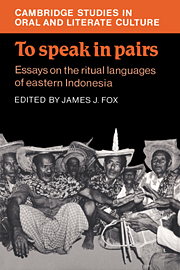Book contents
- Frontmatter
- Contents
- Illustrations
- The contributors
- Acknowledgements
- Introduction
- 1 Etiquette in Kodi spirit communication: the lips told to pronounce, the mouths told to speak
- 2 Method in the metaphor: the ritual language of Wanukaka
- 3 Li'i marapu: speech and ritual among the Wewewa of west Sumba
- 4 The Pattern of Prayer in Weyéwa
- 5 Fashioned speech, full communication: aspects of eastern Sumbanese ritual language
- 6 Manu Kama's road, Tepa Nilu's path: theme, narrative, and formula in Rotinese ritual language
- 7 The case of the purloined statues: the power of words among the Lionese
- 8 The journey of the bridegroom: idioms of marriage among the Endenese
- 9 A quest for the source: the ontogenesis of a creation myth of the Ata Tana Ai
- 10 The Tree of Desire: A Toraja ritual poem
- Notes
- References
- Index
7 - The case of the purloined statues: the power of words among the Lionese
Published online by Cambridge University Press: 19 October 2009
- Frontmatter
- Contents
- Illustrations
- The contributors
- Acknowledgements
- Introduction
- 1 Etiquette in Kodi spirit communication: the lips told to pronounce, the mouths told to speak
- 2 Method in the metaphor: the ritual language of Wanukaka
- 3 Li'i marapu: speech and ritual among the Wewewa of west Sumba
- 4 The Pattern of Prayer in Weyéwa
- 5 Fashioned speech, full communication: aspects of eastern Sumbanese ritual language
- 6 Manu Kama's road, Tepa Nilu's path: theme, narrative, and formula in Rotinese ritual language
- 7 The case of the purloined statues: the power of words among the Lionese
- 8 The journey of the bridegroom: idioms of marriage among the Endenese
- 9 A quest for the source: the ontogenesis of a creation myth of the Ata Tana Ai
- 10 The Tree of Desire: A Toraja ritual poem
- Notes
- References
- Index
Summary
Introduction
This paper deals with problems concerning the efficacy of ritual language. These problems will be investigated in relation to a specific case of stolen communal heirlooms which occurred during the period of my field research in 1983.
In dealing with these problems, we should distinguish two aspects of the efficacy of ritual language: the power of words which are believed to bring to realisation what is intended, and the effectiveness of words in appealing to the imagination.
Like other peoples in central Flores, the Lionese people have a strong belief in the power of words. They insist that curses can kill, discourage, or cause misfortune to persons who are antagonistic to them, and that spells can protect them from misfortune.
Although the thieves who stole the heirlooms were repeatedly cursed in ritual language, they did not seem to die, nor did they reveal themselves, nor return the heirlooms. How could the inefficacy of these curses, then, be reconciled with Lionese belief in the power of words and their confidence in the effectiveness of words?
By interpreting the phrases in the ritual speeches presented in the course of events prompted by the disappearance of the heirlooms, I hope to make clear the Lionese concept of their society and the social role of ritual language. Furthermore, on the basis of this analysis of specific examples of Lionese ritual language, I would like to comment on the general significance of the study of ritual language. And then, by exploring the explanation for the failure of the curse, I would like to elucidate the Lionese theory of the power of words.
- Type
- Chapter
- Information
- To Speak in PairsEssays on the Ritual Languages of eastern Indonesia, pp. 202 - 227Publisher: Cambridge University PressPrint publication year: 1988



